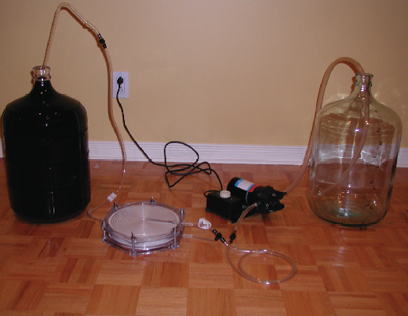 The fun of filtration! I’ll deliver the bad news to you and my readers first by telling you that really no matter how tight of a pore size you use to filter your wines, there is always the possibility of sediment developing over time. In fact, with red wines, it’s actually just about guaranteed.
The fun of filtration! I’ll deliver the bad news to you and my readers first by telling you that really no matter how tight of a pore size you use to filter your wines, there is always the possibility of sediment developing over time. In fact, with red wines, it’s actually just about guaranteed.
You see, a lot of sediment we find in wines actually forms after the wine is bottled, and is nothing that filtration can control. Even if we pass the wine through a nominally “sterile” small pore filter size of 0.45 micron (through which the smallest bacteria cells cannot pass), over time phenolic substances can condense and fall out of solution, as may organic acids and other components. These all accumulate at the bottom of the bottle (or on the side, if that’s how you have it stored) as a fine sediment. In white wines, this is typically seen as the fine crystals of potassium tartrate, unless the wine was intentionally cold stabilized (chilled to force crystal formation and then filtered to remove the crystals) before bottling. Red wines tend to throw more sediment simply because they are not cold stabilized and because they have more “stuff” (tannins, colored components, etc.) to condense into larger molecules and fall out of solution. As a winemaking professor of mine used to quote in bumper sticker speak, “Sediment Happens.”
In your case, however, I would guess that you might have had a microbial interloper or four in your bottles. A 2-micron filter is tight enough to exclude yeast but will allow bacteria to pass through. There are many bacteria in the wine world that can survive very happily in a bottle’s low-oxygen environment. As they go about their merry metabolism business, especially if you had any residual sugar or malic acid in your wine, they can throw out a heck of a lot of sediment.
Similarly, 2-micron filters will take out very large particles of “crud” that may be in your wine and the liquid may look relatively clear, but you’d be surprised how much very fine sediment might be getting through. You lay those bottles down for a few months and, bam! You’ve essentially done another good settling and need to rack again — except this time the wine is already bottled! Why not make sure that your wine is good and settled and leave it in your barrel (or carboy) for another month or two before filtering and bottling?
And just to make sure you’re not getting extra sediment when doing the roughest rack, you might consider doing a “double racking” pre-bottling. This is essentially doing the initial rack of gross lees, and then allowing the racked wine to rest in its holding vessel for at least another week before filtering. This allows the sediment kicked up by the initial rack (and there most probably will be some) to drop to the bottom of the vessel. Filtering off of gross lees is tough, and you’ll probably suck up a lot of fine sediment that way and may even clog your 2-micron filter in the process.
It’s also possible your red blend threw some sediment because the polyphenolic components and tannins just weren’t condensed and “together” enough before you bottled it. I always say that when you bottle a wine, what you get is what you get and you’ve essentially closed the door on the wine’s development. Big, tannic reds typically need more time than whites or lighter reds before they’re bottled because of their high polyphenolic load. The stuff that gives red wines its “guts” will, to an extent, continue to polymerize into larger and larger molecules and typically needs about 16-20 months to do so. The industry standard for a big Cabernet is around 18 months in barrel.
My best advice? If you’re going to go to the trouble of filtering, spring for the 0.45-micron filter and exclude all the little buggies that would want to munch on your wine. Only go to bottle after making sure you’ve let the wine settle out and bulk-age long enough to drop most of its readily formed sediment. Additionally, be sure you are not kicking up a lot of sediment as you rack and prep to go to bottle. Sometimes a red wine will look clear to the eye when it’s really not.




